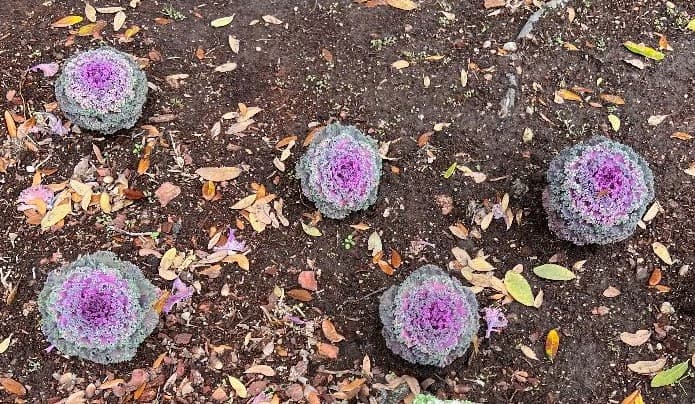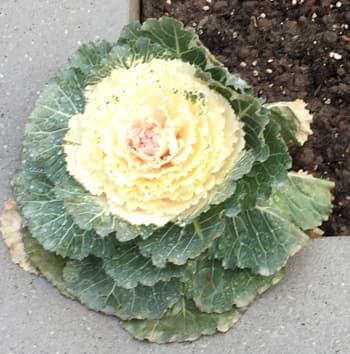How to Grow Flowering Kale Plants

About Growing Flowering Kale Plants in Your Home Garden
Flowering Kale plants are a showy, ornamental grown for their colorful leaves. In the Fall, when other flowers are dying off, Kale gives off a generous splash of color. The cool weather Flowering Kale plant grows better in cool, and even cold weather.
Native to Europe, the plants grow a mounded rosette of deeply lobed, outer leaves in a range of green hues. The colorful center leaves include in pink, white, purple, and reds.
These biennials form an interesting and attractive head in the first year. In the second year, they produce flowers and seeds. Many people do not know this and treat the plant as an annual.
Flowering Kale is edible landscaping. When you are done admiring their colorful display, you can eat the leaves in salads, and any recipe where regular vegetable garden Kale is used. And, you can feel good about eating flowering kale. Like regular Kale, it is high in fiber, potassium, and a wide range of nutrients to help you get and stay healthy. See other Edible Flowers
Try growing Flowering Kale in rock gardens, along walking paths, in containers or in window boxes.
Flowering Kale Plant Specifications
Flower Colors: Outer leaves are a dull grey-green, similar to the color of regular garden Kale. Inner leaf colors include shades of burgundy, purple, and white.
Flowers Bloom: Late Summer through Fall. It survives through winter in warmer regions of the country.
Plant Height: 12″ – 18″
Light Requirements: Partial Sunlight to full sun.
Ideal Soil pH: 5.8 – 6.5.
Hardiness Zone: 2 – 11. This versatile plant grows well in most hardiness zones.
Toxicity: Non-toxic.
Native To: Southern and Western Europe.
Plant Type: Biennial
Botanical Name: Brassica Oleracea
Other Names: Ornamental Cabbage, Ornamental Kale

Is Flowering Kale Edible?
YES!! But, eating it is a matter of taste.
Many people do not like regular garden kale. Even fewer people like the bitter taste of Ornamental Kale.
Medicinal Applications for Flowering Kale
Kale has a variety of health and medicinal uses. Here are some of them:
- Kale has anti-inflammatory and antioxidant properties.
- It has cancer-fighting properties.
- Reduces the risk of heart disease.
- Promotes bone and vision health.
- Kale helps to lower blood pressure.
- Aids in digestive health.
- It plays a role in managing weight.
Light Requirements
In most areas, Flowering Kale grows best in full sunlight. However, it is a cool-weather plant. In hotter regions of the country, plant it in a location where it will receive light shade in the afternoon to protect it from the hot sun.
Flowering Kale Plant Propagation
Flowering Kale is grown from seed. Plants are grown from seeds. Directly sow seeds into your flower garden.
You can also start seeds indoors, 4 – 6 weeks before transplanting.
Sow Kale seeds 1/8 inch deep and cover them with fine garden soil or seeds starting mix. Then, keep the soil moist while the seeds are germinating.
Seeds are quick sprouting.
Days to Germination: 5 – 10 days.
Germination Temperature: 55 – 65 degrees.

How to Grow Flowering Kale Plant
Grow Flowering Kale plants in full sun. They will tolerate partial shade. Kale is a cool weather plant. Consequently, we recommend partial shade, when growing them in hot regions of the country.
Grow in rich, well-drained soil.
This cool-weather flower prefers cool soil and air temperatures 50 to 60 degrees, or lower. After the first frost, it will continue growing.
Keep soil moist, not wet. Water as needed, especially during dry weather.
Fertilize plants once a month, with a fertilizer high in nitrogen. Liquid fertilizers work best for fast growth.
Mulch around plants for a neat and tidy appearance, and to help keep the soil cool and moist.
If you eat the leaves, they are bitter in warm or hot weather, They will turn sweeter after the first frost.
Pruning Flower Kale Plants
Pruning this plant is not required. On rare occasions, there is a sick or dead leave that should be removed.
If you are growing it in the second year, There may be a few leaves that were damaged over the winter. These should be removed.
Insects and Plant Disease
Cabbage Loopers are a common problem. Pick by hand. Cabbage worms and root maggots can also be a problem. If you are not going to eat the Kale, use insecticides, as needed.
Garden Tip: Also, you can place a fine mesh net around the pants to deter cabbage loopers. However, this takes away from the attractive appearance of the plant.
Disease problems are infrequent.
Plant Problems – Identify the causes and find the cures.
Overwintering Biennial Ornamental Kale Plants
Most people do not overwinter these biennial plants. And those who do, are usually planning to collect the seeds for future plantings.
These hardy cold weather plants need no special winter protection.
Related Articles
Also, people who read this article will like:
Please support our site. Shop for:
- rmmatthews100@hotmail.com
- 585-721-6528
- Rochester, NY
©1999-2024 GardenersNet.Com, All Rights Reserved

